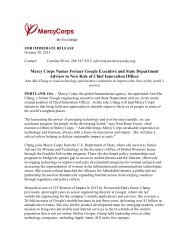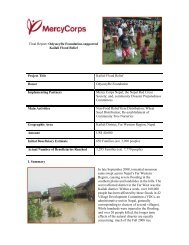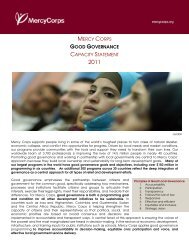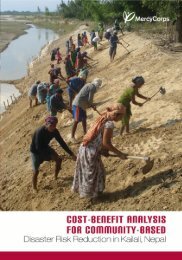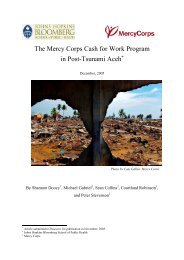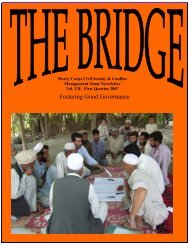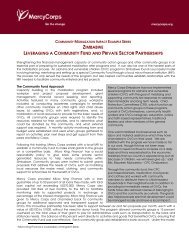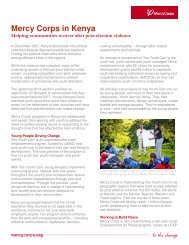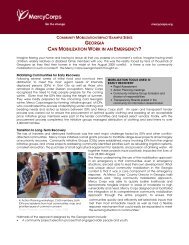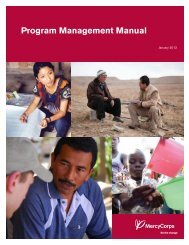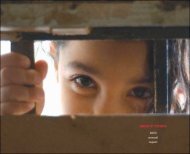SUSTAINABILITY FIELD STUDY - Mercy Corps
SUSTAINABILITY FIELD STUDY - Mercy Corps
SUSTAINABILITY FIELD STUDY - Mercy Corps
You also want an ePaper? Increase the reach of your titles
YUMPU automatically turns print PDFs into web optimized ePapers that Google loves.
CAG members interviewed confirmed that the wholecommunity has access to local community-managedrecords regarding community projects, contributionsand costs. In many of these cases, mechanisms wereorganized for regular reporting to community membersabout the use of contributions through meetings atthe mosque or other community meetings, though itshould be noted that women were at times excludedfrom such reporting at mosques. In some cases, thisinformation was also posted publicly. In Dostuk, theCAG leader, Rodiv Abduvali, was pleased with skillsSANDY SHEARD, 2007 FOR MERCY CORPShe learned during PCI for operating transparently:“We learned transparency. The community selected one person who reports on the activities of theCAG to the wider community.”As stated previously, participation in community meetings in former CAIP and PCI communities wasquite high, with nearly half of youth and general community respondents having attended at least onecommunity meeting between January 2007 and the time the interviews were conducted in July of 2007.This finding suggests that leaders in these communities are regularly sharing informationwith community members. In Komsomol Community of the Khatlon Oblast, one community membertestified that, “People now have more awareness about community events.” And, in the Okjar-Tajikokjarcommunity in Northern Tajikistan, the CAG member, Goibova Kumshoy, explained the change in hercommunity: “Before, the mahalla committee was active and they told people what to do; now they askpeople’s opinion.”Open Decision-MakingIn 57% of communities, there was evidence that at least some of the decision-makingpractices introduced during CAIP and PCI have been adopted for dealing with regularcommunity business. In the town of Aktash, Kyrgyzstan, Taerov Hailil, a CAG member, described itthis way: “We listen to issues from everyone and discuss the pluses and minuses of each, and thenwe vote. We have used this method since 2005 and the last time was one and a half months ago. Wegathered at the school and discussed water, gas and a sports complex, and then decided on a waterproject, which is now being realized. Sixty people participated with five or six from eachmahalla (neighborhood).”Saidov Valijon, a community member from the highly active village of Kichigizi in the Rasht Valley,recognized a big change in how the community interacts following CAIP: “<strong>Mercy</strong> <strong>Corps</strong> showed thecommunity how to organize. We addressed a (community) problem just yesterday.” He went on todescribe the open process by which decisions are now made: “The community lists problems theyhave and then they discuss and prioritize things that will benefit the most people. Issues are discussedin open meetings at the teahouse and decided by a committee. The result is better now with the trustestablished during CAIP.” Mr. Saidov also described local government as being “more accessiblethan before.”B. Recommendations1. Build local government support early.Local government should be involved in all aspects of the mobilization and behavior change process.This statement is especially true in Central Asian countries, where government decentralization policies28Sustainability Field Study



